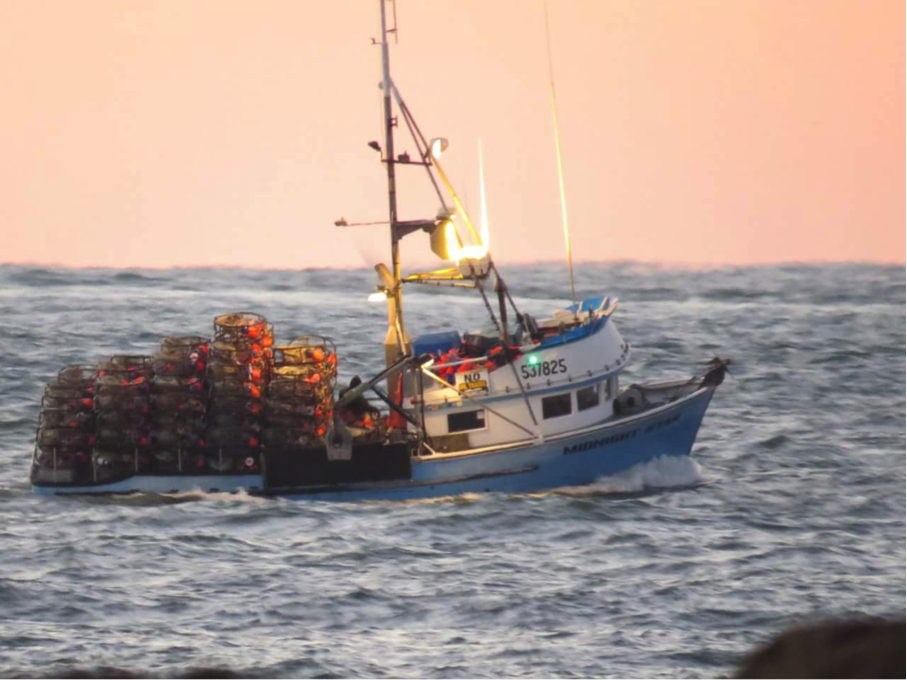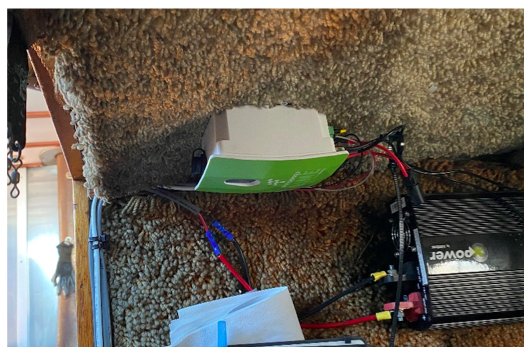Improving Fishery Data
The Washington Department of Fish and Wildlife (WDFW) has relied on commercial fishers to report their fishing location using paper logbooks since 2008. Paper logbooks present several challenges to timely fisheries management due to recording inaccuracies, poor rates of fisher compliance, and the time required for data entry. WDFW has recognized electronic monitoring (EM) as a potential tool to replace paper logbooks and improve the speed and accuracy of data collection to inform fishery management. EM would help WDFW monitor fishing activity in near-real time to confirm catch area reporting, enforce area closures, utilize closed areas to safely manage biotoxins, and support whale conservation by tracking fishing activity and marine mammal co-occurrence.

Developing Electronic Monitoring (EM) Systems
Since 2017, WDFW has pursued grant funding to evaluate the use of an EM system to collect fishing location and effort data necessary to effectively monitor compliance with closed areas. In 2020, WDFW received a National Fish and Wildlife Foundation (NFWF) Fisheries Innovation Fund grant to implement an EM pilot project in the 2020-21 crab season and was subsequently awarded a second grant to continue testing during the 2021-22 crab season. During phase 1 of the project, four vessels were equipped with FishVue LIME (Lite Integrated Monitoring Equipment) one of Archipelago’s newer models in their line of EM products.

Phase 1 objectives were to test the efficacy of the LIME system and an electronic logbook, determine requirements needed for fishery implementation, support fisher participation and provide outreach, and use lessons learned to develop a roadmap for implementation. More information on Phase 1 of the project can be found in a previous article Projects in the Field: Washington Coastal Commercial Dungeness Crab EM Proof-of-Concept – EM4Fish
In Phase 2 of the project, WDFW added an additional eight vessels outfitted with FishVue LIME units, hydraulic pressure sensors, and elecronic logbooks. The following four objectives helped guide the project to develop a plan for EM implementation in the fishery.
Phase 2 Objectives
Objective 1: Expansion of field testing of LIME and E-logbook
By expanding the total number of vessels in the project to twelve, WDFW tested the effectiveness of cellular transmission from different areas of the Washington (WA) coast. WDFW determined the LIME units perform well when storing and sending near real-time data as vessels moved in and out of cellular coverage. A majority of vessel operators found the e-logbook user friendly, with ten out of twelve preferring the e-logbook over a paper logbook. WDFW staff uploaded e-logbook data into existing databases saving time over manual data entry of paper logbooks. Archipelago pushed updates to the e-logbook software cellularly, but the vessel operators didn’t always follow the prompt to update when needed, so the functionality suffered over time.
Objective 2: Define program requirements and data protocols with a higher volume of data
Archipelago and WDFW worked with the Pacific States Marine Fisheries Commission (PSMFC) to establish data protocols that will satisfy WDFW management requirements, keeping in mind that this could be expanded to Dungeness crab fisheries in Oregon and California. PSMFC servers were chosen to store fishing location data along with WDFW fish receiving ticket data, which is already being stored by PSMFC. Archipelago also began working with PSMFC to begin transferring the fishing effort data from all 12 vessels to secure PSMFC servers and are currently working on developing an API to standardize this process. WDFW also worked with Archipelago to develop FishVue Fleet, a tool that is capable of displaying vessel location data for the entire fleet. FishVue Fleet was instrumental in helping WDFW quickly confirm a vessel’s fishing activity. FishVue Fleet is intended to be available to vessel owners to track their own fishing activity as well. WDFW and Archipelago developed parameters to detect pot hauls using hydraulic pressure sensor readings. These data were shown to be useful to enumerate pots fished per day and could be used to enforce pot limits needed for whale entanglement mitigation and management. This data can also be viewed in FishVue Fleet.

Objective 3: Increase stakeholder participation and provide outreach
With the expansion of the pilot project from four vessels to twelve, WDFW increased participation in areas traditionally fished on the WA coast and increased the number of operators able to provide hands on testimony to other fishery participants. An install summary was created for each additional vessel in the pilot to show the different possible configurations for installing the EM system and act as a reference for future installations. WDFW continues to engage the coastal crab industry in all aspects of this project and held three industry-wide meetings to discuss implementation of EM fleetwide.
Objective 4: Report on lessons learned and develop a plan for full EM implementation
WDFW concluded EM, as evaluated in the pilot project, can effectively meet management requirements. WDFW staff used GPS location and hydraulic pressure data to confirm catch area reporting on WA fish receiving tickets and ensure compliance with area closures. Staff determined data from the project would improve WDFW’s ability to track the co-occurrence of fishing gear and marine mammal activity compared to paper logbook data. WDFW also tested additional EM equipment including RFID tag readers to identify individual pots and a laser counter designed to count retained crab. WDFW determined this equipment would not be feasible to use in the fishery due to inaccuracies and the difficulty of maintaining the equipment. The EM proof-of-concept project has allowed WDFW to collaborate with vessel operators during the development of a proposal for full EM implementation in the fishery that can meet management needs.
Implementing an EM Program
WDFW has begun the rule-making process to require an EM system for all fishery participants. Currently the proposed EM rules for the WA coastal Dungeness crab fishery are available for review and public comment. To view the proposed rules please visit: https://wdfw.wa.gov/about/regulations/development/coastal-crab-and-puget-sound-shellfish-updates WDFW also intends to continue testing EM with an emphasis on systems with video capability which may address gear tampering concerns in the coastal Dungeness crab fishery.
Robert Morgan is Region 6 Coastal Shellfish Electronic Monitoring Project Manager for the Washington Dept. of Fish & Wildlife. He welcomes your questions or comments via email. Projects in the Field is a series of independently produced articles profiling work supported by NFWF’s Electronic Monitoring & Reporting Grant Program, and is meant to raise awareness and support for these important initiatives.


